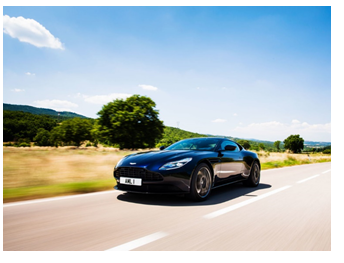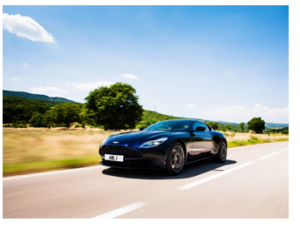Review: 2017 Aston Martin DB11
Aston Martin does two things exceptionally well: soaring success and crushing failure. While stunners like the DBR-1 finished first and second at the 24 Hours of Le Mans in 1959, the company also seems to have declared bankruptcy nearly as many times as it has won races. These things happen when you’ve been in the business of building cars for 103 years.
One thing you can always count on from Aston Martin, though, is style. Its cars have been, for the most part, gorgeous. But since the DB9 ushered in the company’s modern era in 2003, it has become almost visually indistinguishable from its stablemates. Chassis platforms have aged, infotainment systems have become woefully out of date, and, aside from the jaw-dropping One-77 and $2.3 million Vulcan, its cars have settled into a malaise of stylistic repetition.
recommends 2016
2017 ASTON MARTIN DB11
9/10
Learn How We Rate
Wired
Still a mighty V12 beneath the hood, fuel economy legislation be damned; pretty enough to be an Aston, fierce enough to thrill; Jurassic-era infotainment system banished once and for all.
Tired
Turbochargers quell the naturally aspirated shriek; handling quirks to be fixed before production, we hope; lovely analog jewelry traded for digital instrumentation—what price progress?
The 2017 DB11 sees the company returning to form and finally stepping into the 21st century. It’s the first all-new model out of Gaydon under CEO Andy Palmer’s reign, and it aims to reinvigorate a brand that was trapped in a death spiral of limited resources and low volume production.
Along with a $250 million investment in new products and plans to build a second factory in Wales, Aston debuts the new DB11 with the promise of modern technology (finally) and copious panache (but of course). Its performance and refinements surpass the DB9 by such a wide margin, it feels wrong to mention the two cars in the same sentence.
New Suit
Aston Martin has long been defined by superlative design. The DB11, a $211,995 grand tourer suited to crossing vast distances at obscene speeds, updates the company’s vaunted design language while retaining the brand’s signature cues. Function follows form, too, from the “curlicue vents” that draw air from the front wheel wells to reduce lift to the AeroBlade™ (yes, it’s trademarked) that improves downforce. The aerodynamic tricks help the DB11 stay stable while achieving a supercar-worthy 200 mph.
The cabin is no less beautiful, with delightful details like perforated brogues on the seats and doors, crushed carbon-fiber details in the center stack and door trim, and gently sculpted trapezoidal shapes that look nothing like Aston’s late, great waterfall center stack and its odiously out-of-date flip-up nav screen.
Acres of supple, kitten-soft leather from cows that have never seen barbed wire—which might leave unsightly blemishes—covers everything that isn’t made of carbon fiber, polished aluminum, or timber. Aston finally ditched its Byzantine infotainment system and, making use of its technical partnership with Daimler, appropriated their multimedia system. The menu structure and control wheel/touchpad interface is similar to their application in Mercedes-Benz products (known as COMAND), but the graphics have been personalized for Aston.
Although the DB11 is just a bit longer and heavier than the DB9, it feels a lot smaller and lighter, and the suspension matches the engine’s sporting capabilities.Max Earey/Aston Martin
The central 8-inch TFT screen displays nav and music content with sharp resolution. Below, a haptic touch panel to switch modes and control volume, which is a vast and welcome improvement over the old system. But the 12-inch digital instrument cluster is downright disappointing. Sure, everything from the Acura NSX to the McLaren 650S uses customizable renderings of the tachometer. But Aston, the brand whose legendary, jewelry-like analog tachometer had the audacity spin anti-clockwise, now uses a TFT display to convey engine speed.
Turbocharged Power
Aston Martin is nothing if not traditional, steadfastly standing by its venerable V12 engine. Still, it must bow to rising fuel economy standards and tightening emissions regulations. And so the engine in the DB11 displaces just 5.2 liters, and relies upon twin turbochargers for added oomph. Purists will wail, but dropping the hammer in the quickest DB ever should shut them up. This car hits 60 mph from a standstill in well under 4 seconds. Six-hundred horsepower and locomotive-like torque can do that.
Still, let’s take a moment to pour one out. Aston Martin’s naturally aspirated V12s are the stuff of legend, celestial noisemakers that demand to be downshifted in tunnels so that haunting bark reverberates. The DB11 compensates for this by channeling engine intake noise into the cabin (a trick used by everyone from Porsche to Ford) to give you some of that aural thrill, but it’s just not the same. You might drown your sorrows by cranking up the optional 1,000-watt Bang & Olufsen sound system, which renders music with effortless smoothness.
Whatever your ears think, the V12 will please your guts. Bury the pedal, and the DB11 launches hard and strong, with a smooth delivery that is the hallmark of the V12 configuration. The 8-speed transmission interacts seamlessly with the engine, thanks in part to the engine’s generous torque curve. The paddle shifters respond reasonably quickly in GT and Sport modes, and more eagerly in Sport Plus.
Throttle response is excellent for a turbocharged engine, though not quite as crisp as you’d like when the turbos are spooling up. Still, the turbocharged engine is quicker, quieter, and more efficient than anything Aston’s done lately, even if does lack the rough edges and raucous nature that made previous engines such fun.
Aston stayed loyal to the V12, but the DB11’s engine displaces just 5.2 liters, and relies upon twin turbochargers for added oomph. Aston Martin
Throttle response is excellent for a turbocharged engine, though not quite as crisp as you’d like when the turbos are spooling up. Still, the turbocharged engine is quicker, quieter, and more efficient than anything Aston’s done lately, even if does lack the rough edges and raucous nature that made previous engines such fun.
The Digital Era
Although the DB11 is just a bit longer and heavier than the DB9, it feels a lot smaller and lighter, and the suspension matches the engine’s sporting capabilities. New casting joints improve lateral stiffness by 70 percent, a boon for those twisty roads. The multilink rear suspension—a first for Aston—reduces stiffness for a smoother ride.
To optimize performance, onboard computers create a three-dimensional model of the car’s dynamics, based on data including speed, steering angle, steering rate, lateral and longitudinal acceleration, and heave (vertical movement). From there, the car can stiffen or softens the dampers, or glide through corners by applying the inside rear brake. Aston’s first use of electronic, not hydraulic, steering delivers excellent feedback when the car is flung through corners. The system also future-proofs the car to a certain extent, enabling features like self-parking, which can perfectly place the DB11 into a tight parallel spot—should you end up somewhere https://www.wired.com/2016/08/review-2017-aston-martin-db11/without a valet.
All that computer power makes for a wide range of adaptability. GT mode makes for a supple, magic carpet ride; Sport Plus enables handling feats unheard of in the late DB9.
One curious characteristic in our pre-production cars was the tail’s tendency to step out a tad when turning into a hard corner. It was no big deal, the kind of thing you acclimate to after a few turns. But shortly after our drive, Aston dispatched an email announcing software tweaks had resolved the issue by refining the car’s front-rear balance as it enters a corner. Yes, Aston’s analog age is behind it. Now it irons away handling quirks by rearranging ones and zeroes.
The DB11 embraces modernity without looking back, going for broke with a redefined mission to poach well-heeled buyers who might otherwise fall for stalwarts like Bentley, Ferrari, Porsche, and Rolls-Royce. If the DB11 is a sign of things to come, Aston Martin just might live to die another day.
https://www.wired.com/2016/08/review-2017-aston-martin-db11/





